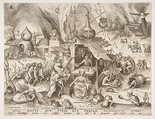Avarice (Avaritia) from the series The Seven Deadly Sins
Pieter van der Heyden Netherlandish
After Pieter Bruegel the Elder Netherlandish
Publisher Hieronymus Cock Netherlandish
Not on view
Representing the vice of greed, this image belongs to a series of prints of the Seven Deadly Sins, engraved by Pieter van der Heyden after drawings by Pieter Bruegel the Elder. The personification of greed, a fashionably dressed woman, sits in the central foreground blithely gathering coins in her lap, while a poisonous toad lurks directly in front of her. The various examples of greedy behavior and its unfortunate consequences, in evidence in the surrounding landscape, effectively demonstrate the message of the inscription below: "Scraping Avarice sees neither honor nor courtesy, shame nor divine admonition." Each of the seven prints follows a similar compositional scheme, with the personification of the vice accompanied by a symbolic animal in the foreground. Bruegel also adopted a common setting and "look" for the series by depicting each scene in the style of Hieronymus Bosch, to whom Bruegel was often compared. Greed features an assortment of fantastic creatures and a disjointed arrangement of hybrid architectural structures reminiscent of Bosch's work. This reminiscent style, employed consciously by Bruegel, contrasts sharply with the way he depicted the Seven Virtues, a series of prints executed in the following years—all of them set in an accurate version of Bruegel's contemporary world.
Due to rights restrictions, this image cannot be enlarged, viewed at full screen, or downloaded.


